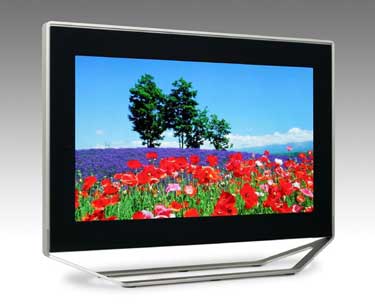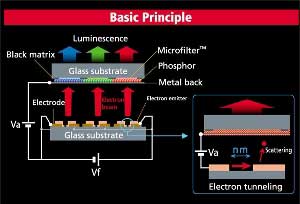Over the last three to four years, the computing world has witnessed a dramatic shift from the traditional CRTs to LCDs. This occurred in part due to the sleek design, low weight, less bulk and low power requirement achieved with the latter which hits snags in CRTs. Also LCD shows much greater potential to build larger and larger panels (Samsung actually introduced a 82'' panel in March 2005) without any drop in clarity.

One might think with all this LCD/plasma buzz, CRT tech is obsolete. Not really; just imagine if you had a CRT with the same dimensions of LCD, with clarity and brightness of CRT or beyond it. This thing is called a SED display with SED standing for Surface Conducting Electron Emitter Display and was first introduced by Canon Inc.
Let's first check out how this thing works. First it is important to note that in a traditional CRT you have got three electron beams of different energy scanning a phosphorescent screen at a rate of say 60 Hz. These beams are emitted by a hot CRT cathode and they pass straight through a perforated anode to the screen. When the electrons in these three beams hit a certain pixel in the screen containing the red, green and yellow phosphors, light is emitted. The electron beams are moved around from row to row top to bottom and continuously either in interlaced or progressive mode depending upon the signal. These glowing points are interpreted by our brain as an image.

In a SED monitor you have not one electron beam but millions! And that implies not one but million picture tubes! No, this is not achieved by making millions of picture tubes but by making millions of microscopic structures, called SCEs (Surface Conduction Emitters). A SCE is a microscopic structure consisting of a layer of carbon with a gap in the middle. One half is given a positive voltage, the other a negative. When the SED circuitry delivers a voltage of about 10 V to the SCE, electrons jump from the cathode of the SCE to its anode. A SED monitor is composed of millions of SCEs arranged in a matrix and a phosphorescent screen with vacuum in between. Here you have got a set of three SCEs for every pixel for each of red, green and blue phosphor. This is analogous to the three beams in a color CRT only that here, you have got millions of SCEs for each phosphor for a certain pixel.
So how do we get the image here? What happens is that in the SCE, the electrons that have jumped (actually tunneled) to anode are picked up by the phosphorescent screen that is charged positively. The electrons go straight for the phosphorescent screen after passing through a very thin aluminum sheet. They strike the phosphors and these glowing dots create the perception of picture.
It is also interesting to note that as opposed to CRT which creates illusion of picture by scanning the screen either in progressive or interlaced mode and building up the picture row by row, SED monitor builds up the entire picture instantaneously at once. This is due to the obvious lack of the old way of scanning the screen via the three beams which build the picture on the screen in a raster pattern. All the SCEs are activated at once to create a complete image.
Interestingly any part of the screen that should appear black does so exactly as the SCE corresponding to that pixel is not activated. So what are the specifications? Well, the specifications that I have been able to glean from the internet for a 36" prototype display are:
Resolution: 1280x720 pixels (a aspect ratio of 16:9)
Response time: < 1 millisecond,
Contrast: 10,000:1
Peak brightness: 450 nits (candela/metre squared)
Power consumption: ~80-100 W
So how do these specs compare with a LCD display? Well one obvious difference is response time which in LCDs is typically 8-16 milliseconds. Such a long response time in LCDs is responsible for blurring or ghosting of the image, in case of rapidly moving images while there is no blur in a SED like that of a LCD. Contrast here even exceeds that of a plasma display which in case of plasma is some thing like 5000:1. Brightness of a LCD or plasma display is of the order of 300 nits so here also SED beats them. The power consumption is really great when ompared to plasma and LCD displays. That’s almost one-fourth of what some 42-inch plasma monitors draw and less than half the power demand of same-size LCD monitors using CCFLs.
Canon introduced the concept and began working on it in 1986. Since then, it has taken 20 years for it to come out of the labs. Inspite of the technical expertise that Canon has, the project is of such a nature that mass producing and marketing this product would have been a nightmare. They therefore formed SED Inc, a joint venture with Toshiba in 2004. Since then various prototypes have been shown at several large trade shows such as the CES 2005, CEATAC 2005 and CES 2006.
The technology was first revealed in 2005 and expected to be released to the consumer market in spring 2006. However, it still hasn't made it to the marketplace. With such an innovative technology in place, why are we not hearing about it any more? Why would that be so? The problem lies in its price. At present, a 55" display is rumoured to cost at least US$10,000! Canon and Toshiba have now moved the release date to this year.
Due to such a high price, there is some scepticism about the commercial viability of this technology. It has to fight against the well established LCD and plasma display giants like Matsushita, Sharp, LG and Samsung who roll out thousands of LCD and plasma panels every month. The odds here are that unless another big player comes in the SED business, this technology would be further delayed. And with LCD and plasma industry booming, who indeed will come in the SED display business? The prospects seem tough.
No comments:
Post a Comment